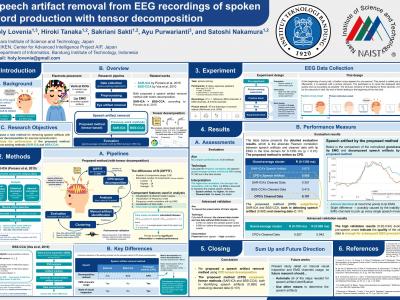Documents
Poster
SPEECH ARTIFACT REMOVAL FROM EEG RECORDINGS OF SPOKEN WORD PRODUCTION WITH TENSOR DECOMPOSITION

- Citation Author(s):
- Submitted by:
- Holy Lovenia
- Last updated:
- 1 May 2019 - 4:29am
- Document Type:
- Poster
- Document Year:
- 2019
- Event:
- Presenters:
- Holy Lovenia
- Paper Code:
- 2998
- Categories:
- Log in to post comments
Research about brain activities involving spoken word production is considerably underdeveloped because of the undiscovered characteristics of speech artifacts, which contaminate electroencephalogram (EEG) signals and prevent the inspection of the underlying cognitive processes. To fuel further EEG research with speech production, a method using three-mode tensor decomposition (time x space x frequency) is proposed to perform speech artifact removal. Tensor decomposition enables simultaneous inspection of multiple modes, which suits the multi-way nature of EEG data. In a picture-naming task, we collected raw data with speech artifacts by placing two electrodes near the mouth to record lip EMG. Based on our evaluation, which calculated the correlation values between grand-averaged speech artifacts and the lip EMG, tensor decomposition outperformed the former methods that were based on independent component analysis (ICA) and blind source separation (BSS), both in detecting speech artifact (0.985) and producing clean data (0.101). Our proposed method correctly preserved the components unrelated to speech, which was validated by computing the correlation value between the grand-averaged raw data without EOG and cleaned data before the speech onset (0.92-0.94).

